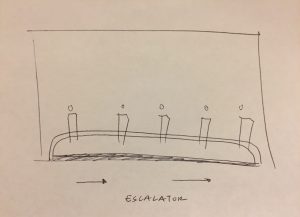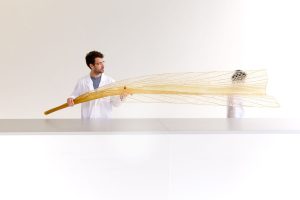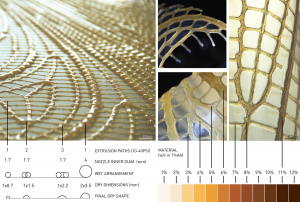var angle = 0; //initial angle
var trees = [];
var bwTrees = 0;
var hillSpeed;
function setup() {
createCanvas(480, 320);
frameRate(10);
hillSpeed = random(0.0001, 0.0005);
for (var i = 0; i < 10; i++){ //display 10 trees at the beginning
var rx = random(width);
trees[i] = makeTree(rx);
}
}
function draw() {
background(202, 244, 235);
drawHill();
drawTree();
addTree();
}
function drawHill() {
beginShape();
stroke(252, 242, 40);
for (var x = 0; x < width; x++) {
var y = 90 + sin(angle) * 30; //used sin graph shape
line(width - x, y, width - x, height);
angle = angle + PI/121; //increment of angle
}
endShape();
stroke(255, 210, 200);
beginShape();
for (var x = 0; x < width; x++) {
var t = x * 0.003 + (millis() * hillSpeed);
var y = map(noise(t), 0, 0.8, 0, height);
line(x, y, x, height);
}
endShape();
beginShape();
stroke(24, 44, 160);
for (var x = 0; x < width; x++) {
var y = 240 + sin(angle) * 30; //used sin graph shape
line(width - x, y, width - x, height);
angle = angle + PI/240; //increment of angle
}
endShape();
}
function drawTree() {
for (var i = 0; i < trees.length; i++){
trees[i].move();
trees[i].display();
}
}
function makeTree(x) {
var tree = {
birth: x,
size: random(20, 60),
speed: -2.0,
move: TreeMove,
display: TreeDisplay,
height: random(30, 60),
color: [255, 62, 54]
}
return tree;
}
function TreeMove() {
this.birth += this.speed;
}
function TreeDisplay() {
var treeHeight = 50;
fill(this.color);
noStroke();
push();
translate(this.birth, height - this.height);
ellipse(0, 0, this.size, this.size);
stroke(255);
strokeWeight(2);
line(0, 0, 0, this.height);
line(0, this.size/5, this.size/6, this.size/20);
if (this.size > 30) {
line(0, this.size/3, -this.size/6, this.size/6);
}
pop();
}
function addTree() {
var newTree = 0.85; //percentage
if (random(0,1) > newTree) {
bwTrees = bwTrees + 1;
if (bwTrees == 4) { // it controls distance between. Two trees are not too close to each other
trees.push(makeTree(width)); //add a tree
bwTrees = 0; //reset
}
}
}
This landscape consists of 3 layers of hills and trees. For 3 layers of hills, Perlin noise and sin graph were utilized as disciplines to depict the shape of hills. Trees are executed with a javascript object and have random sizes and heights. I added more branch based on the size of the tree. It is really fun to keep watching how it continuously changes and create different landscape be each second. Here is one of the nice screenshots below. Also, for color combination, I try not to use typical green colors of hill and tree. I rather explore more experimental colors for this landscape. I think people can clearly see that they are hill/mountain and trees even if it is not with the typical green colors.

![[OLD FALL 2017] 15-104 • Introduction to Computing for Creative Practice](../../../../wp-content/uploads/2020/08/stop-banner.png)







